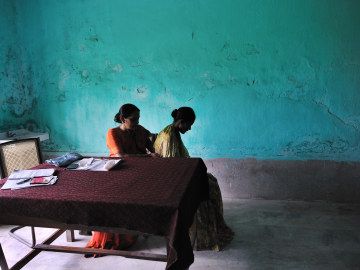Mycetoma: The Untold Global Health Story of 2015
“It is unjust that people don’t care about this disease.”
Writer Amy Maxmen’s words keep surfacing in my thoughts. She said this after her trip to Sudan to report on mycetoma, a flesh-eating, bone-destroying disease that spreads misery across 23 countries from Mexico to India.
Although it’s exacted a horrific toll on human lives for centuries, very little is known about its prevalence or etiology. Bacterial or fungal in origin, the disease starts with a skin infection that over time grotesquely swells feet and other appendages. It erupts in painful lesions on the skin even as it destroys the bones within. Often the only treatment is amputation. Sometimes the disease proves fatal.
Because it afflicts the very poor and doesn’t threaten rich countries, the world doesn’t seem to care. Mycetoma is so neglected that it’s not even on the official WHO list of 17 neglected diseases.
So why should we devote a considerable portion of our limited resources to a 3-part series on such a neglected disease? Early this year, Global Health NOW and our friends at the Consortium of Universities for Global Health launched the 2015 Global Health Untold Stories Contest. Global Health NOW committed to sending a journalist to report on the untold story of the year. After reviewing 170 nominations with our CUGH colleagues, we selected mycetoma.
The disease, nominated by University of Toronto students Annie Liang and Simran Dhunna, hit all of our main criteria. It is a disease or condition with significant impact on global health; it is largely ignored by the mainstream media; and it is in desperate need of better solutions.
After months of preparation and research, in Geneva with the WHO and elsewhere, Maxmen spent 10 days in Sudan in early November. (Most of this project’s cost was supported by a generous donor.) In Khartoum, she met with Professor Ahmed Fahal, who has spent three decades helping mycetoma victims, seeking answers and fighting for global attention. She interviewed people who have lost limbs and livelihoods to the disease. From this research, Maxmen has crafted three stories:
- The first chronicles the lives of people with mycetoma and Professor Fahal’s quest.
- The second explores the concept of neglected diseases and why mycetoma has long been ignored.
- The final story follows new research efforts in Sudan by the Drugs for Neglected Diseases Initiative (which shared Neil Brandvold’s amazing photos with us).
- Please visit the landing page for the series as well featuring stunning photography by Neil Brandvold and links to Q&As with journalist Amy Maxmen and the winners of the Untold Global Health Stories of 2015 contest.
Our hope is that this series not only makes mycetoma a well-told global health story in 2016 but also motivates the WHO to add the disease to its list of neglected diseases—a critical step to prompt funding agencies to support much-needed research.
As Amy Maxmen’s stories vividly demonstrate, mycetoma and its long-suffering victims deserve a sliver of the world’s attention and scientific resources.
Brian W. Simpson, MPH
Editor-in-Chief
Global Health NOW
[email protected]
Please join the thousands of subscribers who rely on Global Health NOW summaries and exclusive articles for the latest public health news. Sign up for our free weekday enewsletter, and please share the link with friends and colleagues: Subscribe to GHN



